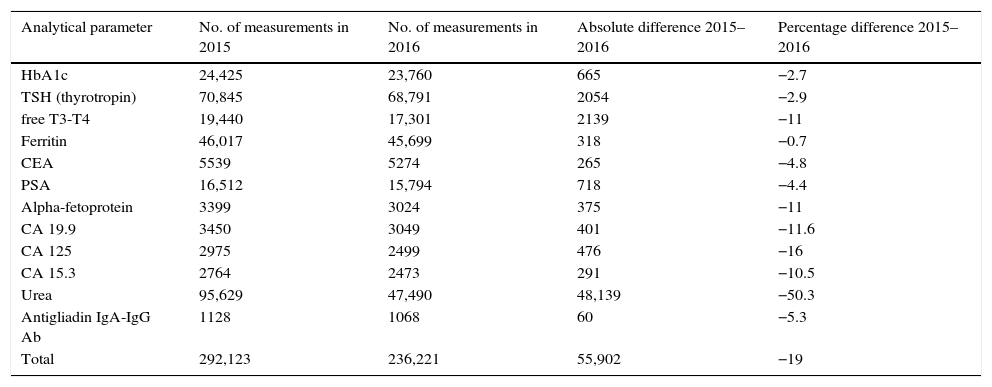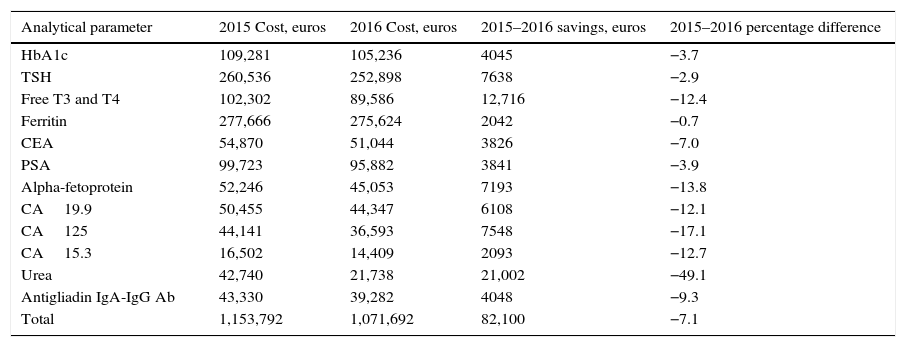In recent years, various scientific societies and healthcare organizations have created recommendations aimed at decreasing the use of healthcare interventions that have shown no efficacy or effectiveness. The aim of this study was to assess the impact of an intervention on 12 do-not-do recommendations regarding the laboratory in 7 hospital centers.
MethodsBefore-after study conducted in 7 hospital centers of Cordoba and Jaen during 2015 and 2016. Based on the recommendations of existing scientific societies, a consensus was reached on various actions regarding laboratory measurements. We analyzed the number and cost of measuring 6 tumor markers (carcinoembryonic antigen, prostate-specific antigen, carbohydrate antigen [CA] 15.3, CA 125, CA 19.9 and alpha-fetoprotein), thyrotropin, T3, T4, glycated hemoglobin, urea, ferritin and antigliadin antibodies, before and after implementing the consensus.
ResultsCompared with the previous year, there were 55,902 fewer laboratory measurements (–19%) in 2016, with an overall savings of €82,100. The reduction in the number of measurements occurred mainly in plasma urea (–50.3%) and in the tumor markers CA 125 (–16%), CA 19.9 (–11.6%) and CA 15.3 (–10.5%). The most pronounced savings were achieved in the measurements of urea (–€21,002), thyroid hormones (–€12,716) and thyrotropin (–€7638).
ConclusionsThe adoption and consensus of do-not-do recommendations among healthcare levels resulted in a significant reduction in unnecessary measurements.
En los últimos años distintas sociedades científicas y organizaciones sanitarias han generado recomendaciones orientadas a disminuir las intervenciones sanitarias que no han demostrado eficacia o efectividad. El objetivo de este estudio es evaluar el impacto de una intervención acerca de 12 recomendaciones de «no hacer» referidas al laboratorio en 7 centros hospitalarios.
MétodosEstudio antes-después llevado a cabo en 7 centros hospitalarios de Córdoba y Jaén durante los años 2015 y 2016. Se consensuaron según las recomendaciones de las sociedades científicas existentes diferentes actuaciones referidas a determinaciones de laboratorio. Se analizaron el número y coste de las determinaciones de 6 marcadores tumorales [(antígeno carcinoembrionario, antígeno prostático específico, antígeno carbohidrato (CA) 15.3, CA 125, CA 19.9 y alfa-fetoproteína)], tirotropina, T3, T4, hemoglobina glicada, urea, ferritina y anticuerpos antigliadina, antes y después de la implantación del consenso.
ResultadosSe dejaron de hacer en el año 2016 respecto al año anterior 55.902 determinaciones de laboratorio (–19%), con un ahorro global de 82.100€. La reducción en el número de determinaciones se produjo principalmente en la urea plasmática (–50,3%) y en los marcadores tumorales CA 125 (–16%), CA 19.9 (–11,6%) y CA 15.3 (–10,5%). El ahorro más acusado se obtuvo en la determinación de urea (–21.002€), en la de hormonas tiroideas (–12.716€) y tirotropina (–7.638€).
ConclusionesLa adopción y consenso de recomendaciones de «no hacer» entre niveles asistenciales conlleva una reducción significativa de las determinaciones innecesarias.
Article
Diríjase desde aquí a la web de la >>>FESEMI<<< e inicie sesión mediante el formulario que se encuentra en la barra superior, pulsando sobre el candado.

Una vez autentificado, en la misma web de FESEMI, en el menú superior, elija la opción deseada.

>>>FESEMI<<<








